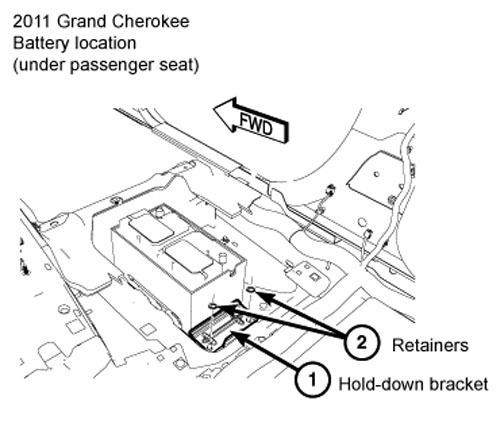Welcome to the JeepSpecs.com in-depth page on the WK2 Jeep Grand Cherokee absorbent glass mat. Did we miss anything? get in touch with us and let us know!
The 2011 and up Grand Cherokees use a new Absorbent Glass Mat (AGM) technology battery. AGM batteries are the latest step in the evolution of lead-acid batteries. Instead of using a gel, an AGM uses a fiberglass like separator to hold the electrolyte in place. This construction is very robust and able to withstand severe shock and vibration and the cells will not leak even if the case is cracked. The AGM battery is a sealed unit that uses special relief valves to vent vapors from the battery. The electrolyte is stored in sponge like separators consisting of matted glass filters. This suspension increases the efficiency of the charging and discharging rate of the battery. Continuous under-and overcharging is detrimental to this type of battery, therefore, voltage and current regulation are critical. AGM’s have a very low self-discharge rate of from 1% to 3% per month.
Battery location, access and removal
The battery is located under the passenger seat. A breather line runs from the battery through the bottom of the recess well to the outside of the vehicle. Remote jump-start posts are located under the hood to assist in jump starting.
Battery removal:
1. Turn the ignition switch to the Off position. Be certain that all electrical accessories are turned off.
2. If equipped with power seats, move the seat to the most forward and upright position. If equipped with manual seats, move the seat to the most forward position.
3. Remove the battery cover.
4. Remove the negative battery cable from the battery.
5. Disconnect the positive battery cable and position aside.
6. Remove the battery thermal blanket.
7. Remove the battery hold down retainers and remove the battery hold down.
8. Remove the battery from the vehicle
Battery charging
NOTE: Typical battery chargers ARE NOT SUITABLE as the voltage and current regulation ranges of typical battery chargers are unsafe for AGM batteries.
This battery has a maximum charging voltage that must not be exceeded in order to restore the battery to its full potential, failure to use the following AGM battery charging procedure could result in damage to the battery or personal injury.
Battery charging is the means by which the battery can be restored to its full voltage potential. A battery is fully-charged when:
- Midtronics GR8-1220KIT-CHRY tester indicates battery is OK.
- Open-circuit voltage of the battery is 12.65 volts or above.
- Battery passes Load Test multiple times.
WARNING: If the battery shows signs of freezing, leaking, loose posts or low electrolyte level, do not test, assist-boost, or charge. The battery may arc internally and explode. Personal injury and/or vehicle damage may result.
WARNING: Explosive hydrogen gas forms in and around the battery. Do not smoke, use flame, or create sparks near the battery. Personal injury and/or vehicle damage may result.
WARNING: The battery contains corrosive materials. Avoid contact with the skin, eyes, or clothing. In the event of contact, flush with water and call a physician immediately. Keep out of the reach of children.
CAUTION: Always disconnect and isolate the battery negative cable before charging a battery. Charge the battery directly at the battery terminals. Do not exceed 14.4 volts while charging a battery.
CAUTION: The battery should not be hot to the touch. If the battery feels hot to the touch, turn off the charger and let the battery cool before continuing the charging operation. Damage to the battery may result.
After the battery has been charged to 12.6 volts or greater, perform a load test to determine the battery cranking capacity. If the battery passes a load test, return the battery to service. If the battery fails a load test, it is faulty and must be replaced.
Clean and inspect the battery hold downs, well, terminals, posts, and top before completing battery service.
CHARGING A COMPLETELY DISCHARGED BATTERY
WARNING: Never exceed 14.4 volts when charging the Absorbent Glass Mat (AGM) starter battery. Personal injury and/or battery damage may result.
The following procedure should be used to recharge a completely discharged battery. Unless this procedure is properly followed, a good battery may be needlessly replaced.
1. Measure the voltage at the battery posts with a voltmeter, accurate to 1/10 (0.10) volt. Refer to Battery Removal and Installation for access instructions. If the reading is below ten volts, the battery charging current will be low. It could take several hours before the battery accepts a current greater than a few milliamperes. Such low current may not be detectable on the ammeters built into many battery chargers.
2. Disconnect and isolate the battery negative cable. Connect the Midtronics GR8-1220KIT-CHRY.
NOTE: Some battery chargers are equipped with polarity-sensing circuitry. This circuitry protects the battery charger and the battery from being damaged if they are improperly connected. If the battery state-of-charge is too low for the polarity-sensing circuitry to detect, the battery charger will not operate. This makes it appear that the battery will not accept charging current. See the instructions provided by the manufacturer of the battery charger for details on how to bypass the polarity-sensing circuitry.
3. Battery chargers vary in the amount of voltage and current they provide. The amount of time required for a battery to accept measurable charging current at various voltages is shown in the Charge Rate Table. If the charging current is still not measurable at the end of the charging time, the battery is faulty and must be replaced. If the charging current is measurable during the charging time, the battery may be good and the charging should be completed in the normal manner.

